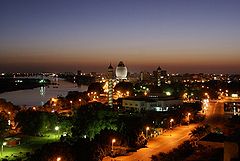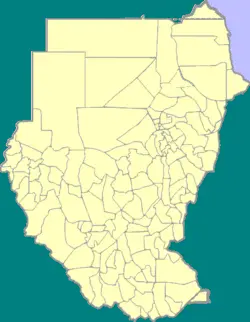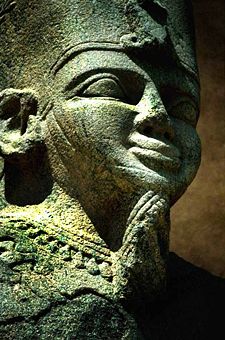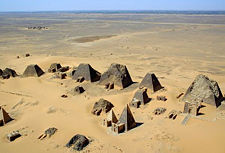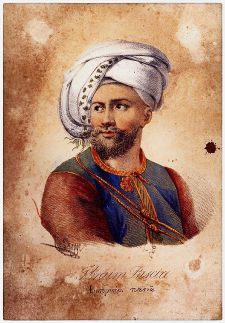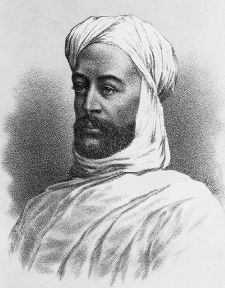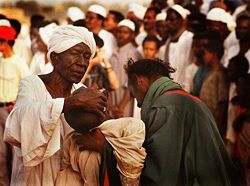Khartoum
| Khartoum ۧÙ۟۱۷ÙÙ al-KharáčĆ«m |
|||
| Khartoum at night | |||
|
|||
| Nickname: The Triangular Capital | |||
| Khartoum's location in Sudan | |||
| Coordinates: 15°38âČN 032°32âČE | |||
|---|---|---|---|
| Country | |||
| State | Khartoum | ||
| Government | |||
| Â -Â Governor | Abdul Rahman Alkhidir | ||
| Population (2008) | |||
| Â - Urban | 639,598 | ||
| Â - Metro | 5,274,321 (Khartoum State) | ||
| Time zone | EAT (UTC+3) | ||
|  - Summer (DST) | Not Observed (UTC+3) | ||
Khartoum (ۧÙ۟۱۷ÙÙ
al-KharáčĆ«m), located at the confluence point of the White Nile and the Blue Nile, is the capital of Sudan and of Khartoum State.
Although the region has had a history that included the Kushite, Meroitic, Alodic, and Sennar Kingdoms, as well as Christian and Islamic religious influence, the city of Khartoum was not founded until 1821, as an outpost for the Egyptian army.
Khartoum was the site of a massacre of an Anglo-Egyptian garrison by religious Mahdist troops in 1885, was retaken by British forces in 1898, and was subsequently the capital of a de facto British colony.
Since Sudan's independence in 1956, Khartoum has been largely embroiled in civil war, and has been the destination of masses of refugees from the surrounding Sudan countryside, and from neighboring war-torn countries.
Divided by the Blue and White Niles, Khartoum is a tripartite metropolis consisting of Khartoum proper, and linked by bridges to Khartoum North called al-KhartĆ«m BahrÄ« and Omdurman (Umm DurmÄn) to the west.
Geography
The word Khartoum means "elephantâs trunk" in the local dialect, and is probably derived from the narrow strip of land between the Blue and White Niles, which is likened to the trunk of an elephant.[1]
Khartoum is located at the confluence point of the White Nile flowing north from Lake Victoria, Uganda, and the Blue Nile flowing west from Ethiopia. The location where the two Niles meet is known as "al-Mogran." The main Nile continues to flow north towards Egypt and the Mediterranean Sea.
The White Nile originates in equatorial regions, where rainfall occurs throughout the year, so it runs at a nearly constant rate. The Blue Nile flows out of the Ethiopian highlands, where rainfall is more seasonal. The Blue Nile swells in the late summer and early autumn with rains from the summer monsoons. The flow at these times can be so great, causing the Nile to flow backward at the junction. Heavy monsoon rain brings floods in Khartoum.
Khartoumâs average maximum temperature is over 100°F (38°C) and prevails from February to November. An average maximum of 94°F (34°C) characterizes the remaining two months. Sandstorms (huboobs) are common from May until August. Mean annual precipitation is 6.2 inches (157.5 mm).
At an elevation of 1,265 feet (386 meters), the city has a low profile, dominated by sprawling areas of small buildings that are supported by little infrastructure.
History
The first developed societies appeared in Nubia, later known as northern Sudan, before the time of the first dynasty of Egypt (3100-2890 B.C.E.). Around 2500 B.C.E., Egyptians began moving south, finding the northern Sudan area occupied by the ancient African Kingdom of Kush. The region came under Egyptian rule from about 1500 until about 780 B.C.E. The people of Kush prospered, enjoying internal and external peace. About 750 B.C.E., a Kushite king called Kashta conquered Upper Egypt and became ruler of Thebes until approximately 740 B.C.E.
In 590 B.C.E., the Egyptian army forced the Kushite court to move to Meroe, approximately 300 miles (500 km) northeast of Khartoum. In the second and third centuries B.C.E., Meroe extended to Sawba, near present-day Khartoum. About 350 C.E., an army from Abyssinia captured and destroyed Meroe city, ending the kingdom's independent existence.
By the sixth century, three states had emerged from the Meroitic Kingdom. Nobatia in the north, in what is now Egypt; the central kingdom, Muqurra (Makuria), was centered about 90 miles (150km) south of modern Dunqulah; and Alawa (Alodia), in the heartland of old Meroe, which had its capital at Sawba (now a suburb of modern-day Khartoum).
Byzantine empress Theodora (500-548) sent a missionary who started preaching Christianity to Nobatia about 540 C.E. The Nubian kings became Monophysite Christians. However, Makuria was of the Melkite Christian faith, unlike Nobatia and Alodia.
Islam came to Egypt in the 640s, and pressed south. Around 651, the governor of Egypt raided as far south as Dunqulah, meeting resistance and finding little wealth. Thus, a treaty known as the baqt was signed between the Arabs and Makuria, and held for some 700 years.
Southern Sudan was home to a variety of semi-nomadic tribes. In the sixteenth century one of these tribes, known as the Funj, moved north and united Nubia forming the Kingdom of Sennar. The Funj sultans quickly converted to Islam and that religion steadily became more entrenched. At the same time, the Darfur Sultanate arose in the west. Between them, the Taqali established a state in the Nuba Hills.
In 1820â1821, an Ottoman force conquered and unified the northern portion of the country.
Ibrahim Pasha (1789â1848), the adopted son of Muhammad Ali, the ruler of Egypt, founded Khartoum in 1821 as an outpost for the Egyptian army, and the seat of Egyptian rule in Sudan. The location at the confluence of the White and Blue Nile meant the settlement grew as a regional center of trade, including the slave trade.
By 1840, its population was 30,000. The town was an unplanned agglomeration of dirty mud buildings interspersed with native thatched huts.
Ismail Pasha, the khedive of Egypt from 1863-1879, attempted to extend Egyptian rule to the south, bringing in the British influence. The Egyptians developed Sudanâs trade in ivory and slaves. During the 1870s, European initiatives against the slave trade caused an economic crisis in southern Sudan.
In 1881, a religious leader named Muhammad ibn Abdalla (1844â1885) proclaimed himself the Mahdi ("guided one") and began a war to unify the tribes in western and central Sudan. Troops loyal to the Mahdi Muhammad Ahmad began a siege of Khartoum on March 13, 1884, against the defenders led by British General Charles George Gordon (1833â1885). The siege resulted in the massacre of the Anglo-Egyptian garrison. The heavily damaged city fell to the Mahdists on January 26, 1885.
The Mahdists set up their capital in Omdurman, which was the scene of the bloody battle on September 2, 1898, during which British forces under Horatio Kitchener defeated the Mahdist forces defending the city.
In 1899, Sudan was proclaimed a condominium under British-Egyptian administration, and Khartoum became the capital. The town was laid out, for military purposes, in a series of patterns resembling the Union Jack British flag. At that time, the smaller town of Khartoum North, on the Blue Nile opposite Khartoum, began to grow as an arsenal and storehouse.
From 1898, the United Kingdom and Egypt administered all of present day Sudan, but northern and southern Sudan were administered as separate colonies. Most of the British focus was on developing the economy and infrastructure of the north.
In 1943, the British began preparing the north for self-rule, establishing a North Sudan Advisory Council to advise on the governance of the six North Sudan provinces: comprising of Khartoum, Kordofan, Darfur, and Eastern, Northern and Blue Nile provinces.
Then, in 1946, the British colonial authority reversed its policy and decided to integrate north and south Sudan under one government. South Sudanese authorities were informed at the Juba Conference of 1947 that they would now be governed by a common administrative authority with the north. Many southerners felt betrayed by the British because they were largely excluded from the new government.
Sudan achieved independence on January 1, 1956, under a provisional constitution, with Khartoum the capital. However, the Arab-led Khartoum government reneged on promises to create a federal system. Southern army officers rebelled, sparking 17 years of civil war (1955-1972). In the early period of the war, hundreds of northern bureaucrats, teachers, and other officials serving in the south were massacred.
In 1972, the Addis Ababa Agreement led to a cessation of the north-south civil war, allowing a degree of self-rule, causing a 10-year hiatus in the civil war. The Sudanese government became more pro-Western, and made plans to export food and cash crops. However, commodity prices declined throughout the 1970s causing economic problems for Sudan.
In 1973, Khartoum was the site of a hostage crisis in which members of Black September held 10 hostages at the Saudi embassy, five of whom were diplomats. The U.S. ambassador, the U.S. deputy ambassador, and the Belgian chargé d'affaires were murdered. The remaining hostages were released.
The first oil pipeline between Khartoum and Port Sudan was completed in 1977.
Throughout the 1970s and 1980s, Khartoum was the destination for hundreds of thousands of refugees fleeing conflicts in neighboring nations such as Chad, Eritrea, Ethiopia and Uganda. The refugees settled in large slums at the outskirts of the city. From the mid-1980s onward, large numbers of internally displaced people from the violence of the Second Sudanese Civil War and Darfur conflict have settled around Khartoum.
In 1983, the civil war was reignited following President Gaafar Nimeiryâs decision to circumvent the Addis Ababa Agreement, by attempting to create a Federated Sudan including states in Southern Sudan. The government's Islamization policy which would have instituted Islamic law, among other things.
The second civil war went on for more than 20 years, resulting in the deaths of 2.2 million Christians and Animists. It displaced roughly 4.5 million people within Sudan and into neighboring countries. It also damaged Sudanâs economy leading to food shortages resulting in starvation and malnutrition.
Following the 1998 U.S. embassy bombings, the United States accused Osama bin Laden's al-Qaeda group of responsibility and launched cruise missile attacks (August 20) on the al-Shifa pharmaceutical factory in Khartoum North. The destruction of the factory produced diplomatic tension between the U.S. and Sudan.
The Naivasha peace treaty was signed on January 9, 2005, in Nairobi, granting Southern Sudan autonomy for six years, followed by a referendum about independence. The United Nations Mission In Sudan was established in March 24, 2005, to support implementation of the Comprehensive Peace Agreement.
After the sudden death of Sudan People's Liberation Army head and vice-president of Sudan John Garang at the end of July 2005, there were riots in the capital for days, leaving 24 dead.[2]
On May 10, 2008, a Darfur rebel group known as the Justice and Equality Movement battled Sudanese government forces in Khartoum in a bid to topple Omar Hassan al-Bashir's government. The Sudanese government repelled the assault.[3][4][5]
Government
Sudan has a Government of National Unity, consisting of the National Congress Party and Sudan People's Liberation Movement, who formed a power-sharing government under the 2005 Comprehensive Peace Agreement. The National Congress Party, which came to power by military coup in 1989, is the majority partner. The agreement stipulates national elections in 2009.
Sudan is divided into 25 states (wilayat, sing. wilayah) which in turn are subdivided into 133 districts. Khartoum is the capital of the Khartoum State, which had an estimated population of approximately 4,700,000 in 2000.
Economy
Sudan's economy was booming in 2008 on the back of increases in oil production, high oil prices, and large inflows of foreign direct investment. GDP growth registered more than 10 percent per year in 2006 and 2007. Agricultural production remains important, because it employs 80 percent of the work force and contributes a third of GDP. The Darfur conflict, the aftermath of two decades of civil war in the south, the lack of basic infrastructure in large areas, and a reliance by much of the population on subsistence agriculture ensure much of the population will remain at or below the poverty line for years despite rapid rises in average per capita income.
Per capita GDP was estimated at $1900 in 2007.
Although poor, with few paved streets, Khartoum is a trade and communications center, with rail lines from Egypt, Port Sudan, and El Obeid, river traffic on the Blue and White Nile rivers, and Khartoum International Airport, is located in the heart of the city. A new international airport was under construction in 2008 in the city of Omdurman.
It has four bridge connections across the Blue Nile to Khartoum North, and four (with two more proposed in 2008) across the White Nile to Omdurman. The three cities form The Sudanâs largest conurbation.
Industries include printing, glass manufacturing, food processing, gums, and textiles.
Petroleum products are produced in the north of Khartoum state, providing fuel and jobs for the city. One of Sudan's largest refineries is located in northern Khartoum. An oil pipeline between Khartoum and Port Sudan was completed in 1977.
A $4-billion project, known as the Al-Mogran Development Project, seeks to develop several thousand acres in downtown Khartoum along the spot where the White Nile and Blue Nile merge to form the Nile. Oil wealth has provided funding for this project. Begun in 2004, the project is expected to produce 11,000,000 square feet (1,000,000 square meters) of office space, 1100 villas, housing for 45,000 residents and visitors, and jobs for 60,000 Sudanese.
Demographics
Khartoum is one of the largest Muslim cities in North Africa. Sunni Muslims, which make up 70 of Sudan's population, are concentrated in the north of the country; Christians make up five percent and are mostly in south and Khartoum; while 25 percent follow indigenous beliefs. Khartoum has Roman Catholic, Anglican, and Coptic cathedrals, Greek and Maronite churches, and several mosques.
Black people make up 52 percent of Sudan's population, Arab 39 percent, Beja 6 percent, foreigners 2 percent, and others 1 percent. Sudan has faced large refugee influxes from neighboring countries, primarily Ethiopia and Chad.
Arabic is the official language. English is widely spoken, and is an official language. More than 100 languages and dialects are identified, including Nubian, Ta Bedawie, diverse dialects of Nilotic, Nilo-Hamitic, Sudanic languages. A program of "Arabization" was in progress in 2008.
Khartoum is the location of the University of Khartoum, founded as Gordon Memorial College in 1902 and renamed in the 1930s, Juba University, which is the only university in Sudan to maintain English as language of instruction, Computerman College, Al Neelain University, Sudan University of Science and Technology, Bayan Science and Technology University, the Academy of Medical Sciences and Technology, Omdurman Islamic University, Ahfad University for Women, the Academy of Medical Sciences and Technology, and the Comboni College for Science and Technology.
Places of interest
The National Museum of Sudan, which was founded in 1971, is the largest museum in Sudan. Notable exhibits are two Egyptian temples of Buhen and Semna, which were built by Queen Hatshepsut and Pharaoh Tuthmosis III respectively, but relocated to Khartoum upon the flooding of Lake Nasser between 1958 and 1970. The Palace Museum is located next to the Presidential Palace on Blue Nile Street. Other sites of interest include:
- The Souq Arabi market is spread over several blocks in the center of Khartoum proper just south of the Great Mosque (Mesjid al-Kabir) and the minibus station. It is divided into separate sections, including one focused entirely on gold.
- Afra Mall mall, which has a supermarket, retail outlets, coffee shops, a bowling alley, and a movie theater, is located in the southern suburb of Arkeweet.
Khartoum is home to a small botanical garden, in the Mogran district.
Looking to the future
Sudan's economy was booming in 2008 on the back of increases in oil production, high oil prices, and large inflows of foreign direct investment. The $4-billion Al-Mogran Development Project is expected to provide substantial areas of office space, housing, and a large number of jobs, all of which will boost Khartoum's economy.
But Khartoum is the capital of a country that has been dominated by military regimes favoring Islamic-oriented governments since independence, and that has been embroiled in two prolonged civil wars, both of which were rooted in the northern domination of largely non-Muslim, non-Arab southern Sudanese.
These issues, plus the Darfur conflict, the presence of large numbers of displaced persons, insufficient infrastructure, and a reliance on subsistence agriculture, combine to keep much of Sudan's population at or below the poverty line for years, and will add to challenges facing Khartoum.
Notes
- â C.E.J. Walkly, The three towns: Khartoum, North Khartoum and Omdurman, U.S. Department of State. Retrieved December 15, 2008.
- â BBC News,. August 1, 2005, Riots after Sudan VP Garang dies. Retrieved December 15, 2008.
- â Sudan Tribune, May 10, 2008, Curfew in capital as Sudanese army clash near Khartoum with Darfur rebels. Retrieved December 15, 2008.
- â BBC News, May 10, 2008, Sudanese rebels "reach Khartoum." Retrieved December 15, 2008.
- â Sudan Tribune, May 10, 2008, PHOTOS: Sudan capital after today's attack. Retrieved December 15, 2008.
ReferencesISBN links support NWE through referral fees
- Atteridge, A. Hillia. 2007. Towards Khartoum: The Story of the Sudan. Gardners Books. ISBN 9781432651435.
- Butler, Daniel Allen. 2007. The First Jihad: The Battle for Khartoum, and the Dawn of Militant Islam. Havertown, PA: Casemate. ISBN 9781932033540.
- Chenevix Trench, Charles. 1979. The Road to Khartoum: A Life of General Charles Gordon. New York: Norton. ISBN 9780393012378.
- Collins, Robert O. 2005. "Khartoum." Encyclopedia of African History. 764-765. OCLC 143619337.
- Farwell, Byron. 1967. Prisoners of the Mahdi; the Story of the Mahdist Revolt Which Frustrated Queen Victoria's Designs on the Sudan, Humbled Egypt, and Led to the Fall of Khartoum, the Death of Gordon, and Kitchener's Victory at Omdurman Fourteen Years Later. New York: Harper & Row. OCLC 420988.
- Hamdan, G. "The Growth and Functional Structure of Khartoum." Geographical Review, Vol. 50, No. 1 (Jan., 1960), pp. 21-40. American Geographical Society
- Kudrati M., M.L. Plummer, and N.D. Yousif. 2008. "Children of the sug: A study of the daily lives of street children in Khartoum, Sudan, with intervention recommendations." Child Abuse & Neglect. 32 (4): 439-48. OCLC 264289953.
- Reeves, Eric. 2001. "ARTICLES - RAPACIOUS INSTINCTS IN SUDAN - Oil companies are partners with Khartoum in waging a cruel civil war." The Nation. 272 (22): 23. OCLC 93119728.
- Walt, V. 2007. "Khartoum Boom." Fortune. 156 (3): 30-37. OCLC 210395286.
- World Fact Book. 2008. Sudan.
External links
All links retrieved March 2, 2025.
- Earth from Space Khartoum from space
| |||||||||||||
Credits
New World Encyclopedia writers and editors rewrote and completed the Wikipedia article in accordance with New World Encyclopedia standards. This article abides by terms of the Creative Commons CC-by-sa 3.0 License (CC-by-sa), which may be used and disseminated with proper attribution. Credit is due under the terms of this license that can reference both the New World Encyclopedia contributors and the selfless volunteer contributors of the Wikimedia Foundation. To cite this article click here for a list of acceptable citing formats.The history of earlier contributions by wikipedians is accessible to researchers here:
The history of this article since it was imported to New World Encyclopedia:
Note: Some restrictions may apply to use of individual images which are separately licensed.
